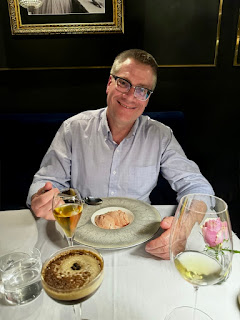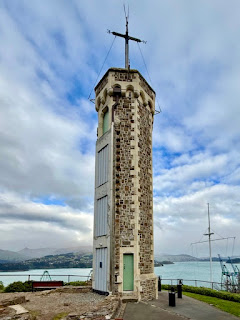Sunday, July 13, 2025
Why we love our apartment
Posted by
Swatch
at
8:37 pm
Saturday, July 12, 2025
Sin City
Time for another retrospective post. This time we’re off to Las Vegas. I’ve visited this desert city at least three times in the last 25 years. Growing up, I’d often see the bright lights of Vegas as an iconic backdrop for popular television shows and movies. This gambling mecca, with its themed hotels, glittering stage shows and dazzling lights, was considered Disneyland for adults.
I finally got to visit the infamous Sin City for the first time in 2000. At the time, I was on my way to Text 100's San Francisco office for a two-week General Manager’s secondment. I flew into LA on Friday, 28 July, passed through immigration and transferred mid-morning onto a flight to Las Vegas.
I finally got to visit the infamous Sin City for the first time in 2000. At the time, I was on my way to Text 100's San Francisco office for a two-week General Manager’s secondment. I flew into LA on Friday, 28 July, passed through immigration and transferred mid-morning onto a flight to Las Vegas.
For guests not keen on making a wager, the hotel offered a massive video game arcade and carnival-type games. These amusements were in a central atrium called The Midway, which also featured a carousel operating as a bar. I can still recall watching trapeze artists swinging above patrons while sitting at the bar.
However, upon arrival in Las Vegas, I decided to set aside the hotel’s attraction in favour of one that had captured my imagination years earlier. I walked up the strip to Stratosphere, a classic skyline tower with a revolving restaurant and observation deck. The tower is more than 350 metres high, the tallest of its kind in the USA, and second only to Toronto's CN Tower in all of North America.
The top of the tower contained two thrill rides, Big Shot, a free-fall drop, and High Roller, a spiralling rollercoaster that sits on top of the observation pod. I was keen to try a rollercoaster ride operating 277 metres above the ground.
Big Shot was a big mistake! This ride travels up and down the tower's needle, dropping riders from a high of 329 m to the top of the outdoor observation deck. Let’s just say, jet lag and an inner ear imbalance caused by 14 hours of juddering flight, played havoc on my nerves. The free-fall sensation was simply terrifying.
In contrast, High Roller proved to be a dud. The rollercoaster circles the pod on tracks with a relatively modest drop, at a rather sedate speed. It was more akin to an old-fashioned wooden roller coaster ride in terms of its adrenaline rush. The tracks were also set back from the very edge of the observation pod, and thus any sensation of flying through the air was relatively limited. Apparently, my underwhelming experience was shared by others. According to Wikipedia, it was never popular. As a result, the rollercoaster closed on December 30, 2005, and was dismantled.
Big Shot was a big mistake! This ride travels up and down the tower's needle, dropping riders from a high of 329 m to the top of the outdoor observation deck. Let’s just say, jet lag and an inner ear imbalance caused by 14 hours of juddering flight, played havoc on my nerves. The free-fall sensation was simply terrifying.
I consoled myself later with a ride on The Big Apple Coaster at New York New York. This rollercoaster travels at 67mph, features a 180-degree “heartline” twist and dive manoeuvre and a stomach-churning 44 metre high speed drop. A section of this coaster even passes through the hotel's atrium. Way more exciting than the High Roller, as you can see in the second image above.
I also recall checking out the white tigers on display in a glass-walled enclosure inside the Mirage resort. They were part of Siegfried and Roy’s magic show for many years until a tiger mauled Roy Horn in 2003. I never did get to see the show before it closed.
While in Las Vegas, I booked a helicopter flight into the Grand Canyon. I made a return visit to the Grand Canyon when I visited Las Vegas a second time in 2002. You can read about these adventures here.
My return visit was a weekend side trip I’d tacked onto another business trip to the USA. I made the most of my return by visiting attractions I’d missed a few years earlier. This included a day tour to Hoover Dam. The tour included a visit to the turbine hall inside the dam (impressive!). Our guide also took us through corridors buried deep inside the dam, before taking a lift down to an outdoor deck above the penstock outlet. Here we could look up towards the crest of the dam. For a Civil Engineering geek like me, it was pure heaven.
I also recall going to the movies one afternoon to see the recently released Star Wars prequel, Episode II – Attack of the Clones. However, if I’m totally honest, I saw it because I was bored. If you’re not into gambling, there are only so many things available to fill your time. The evenings are different. I’ve attended many spectacular stage shows over the years.
My Vegas show list includes O by Cirque du Soleil at the Bellagio, a rival water extravaganza called Le Rêve at the Wynn Resort, Mystère by Cirque du Soleil at Treasure Island and the Blue Man Group at the Luxor. However, I’ve never been in town while a major artist like Celine Dion was conducting a residency show.
Garry and I returned to Las Vegas for the first time together in August 2010. Highlights from this trip included the Titanic Exhibition at The Luxor. This was an impressive exhibit of artefacts and memorabilia from the ship, including a large section of the hull salvaged in 1998. This impressive structure weighs more than 14 tonnes and was retrieved from the ocean floor at a depth of 3,700 metres.
The Strip in 2000
The Strip in 2010
Posted by
Swatch
at
10:22 am
Saturday, July 05, 2025
The Sunshine Coast
This is my first time on the Sunshine Coast. Garry and I decided to fly here to cash in a Qantas travel credit that was about to expire. We’ve also talked about buying a second home further north as a warm winter retreat. I’ve suggested anywhere between Yamba (near Ballina) and Noosa would be ideal. We’d then be close to a regional airport, making it easy to reach, and close to an international airport if we ever relocated permanently, i.e. Brisbane Airport.
Last Summer we spent a couple of weeks exploring Yamba, Ballina and Lennox Head. We’ve also stayed on the Gold Coast several times, including a weekend in Surfers Paradise in 2023, and a business trip to Broadbeach last November. This left just the Sunshine Coast to vet and explore.
We’ve cashed in some Accor loyalty points to secure an oceanfront apartment overlooking the Mooloolaba headlands and nearby Alexandra Beach. Sadly the room can only be described as “functional” at best. However, the weather has been superb with highs of 21C. Garry and I were out in short sleeves while visiting Noosa yesterday. This is exactly how I envisioned a winter retreat destination.
On Thursday we explored the outer suburbs of Maroochydore, Kawana Waters, Birtinya, Bokarina and Mooloolaba. Yesterday, we drove up the coast through central Maroochydore, and on to Twin Waters, Marcoola, Coolum Beach, Sunshine Beach and Noosa Heads. We now have a great feel for the Sunshine Coast, and know exactly what our money will buy. Watch this space.
UPDATE: 10:30pm
We’ve finished off our long weekend with a superb meal at Belle Venezia. This is an award-winning Italian restaurant on the foreshore at Mooloolaba. Garry went for the Morton Bay Bug spaghetti, while I tried the crayfish ravioli. However, the highlight of the evening was undoubtedly the locally made Blood Orange sorbet.
Posted by
Swatch
at
8:53 am
Wednesday, July 02, 2025
Banks Peninsula
Sadly my mother’s older brother, Uncle Rich, passed away last week after a brief illness. His death was caught everyone by surprise. Unlike my mother, Dick was still living semi-independently and was relatively high functioning despite the onset of dementia in recent years.
I got wind of his sudden illness while visiting Queenstown. He died the day after I returned to Sydney. After some reflection, I decided to cross the Tasman again for his funeral. In part, I wanted to honour the effort so many relatives made in attending my Mum’s funeral last year. I was also keen to support my Auntie Pam, Mum’s older sister, who’s lost two siblings in a single year.
The decision was easy to make thanks to a super cheap airfare. I cashed in some frequent flyer points and flew to Christchurch for less than $270. I also scored a great hotel deal via Amex, plus a discounted rental car for the weekend. Lo and behold, I found myself back in the Qantas First Class lounge at the crack of dawn on Saturday morning.
I eventually came across a hilltop reserve offering an unrivalled view of Lyttelton. I arrived just in time to watch the hill’s lengthening shadow extinguish the sun’s final rays over the town. Chatteris Bay looked equally stunning in the distance. The view did come at a cost. The wind was bitterly cold. It left me shivering and I all but lost sensation in my hands. I finished the afternoon with an impromptu visit to Pam’s house before finally checking into my hotel shortly after 6:00pm.
I’m so glad stopped at the spit. It’s an incredible geographical formation. Much to my surprise I discovered the broad beach and expansive dunes consist entirely of smooth oval gravel pebbles. Incredibly they’ve all come from the Southern Alps, swept down to the coast by the braided Rakaia River, about 40km down the coast. Their smooth and rounded appearance reflects their origin as rubble ground smooth by glaciers grinding their way through the alps.
We finished our morning with a scenic drive along the coast to Sumner, before returning to my hotel to prepare for Dick’s funeral. The remainder of the day was taken up by the service, and subsequent reception, before returning to cousin Nicki’s home for a light supper. The service bought back fond childhood memories, as well as sad moments reflecting on my mother’s death 12 months ago.
I took Matt and my cousin, Roanne, to the airport about 6:15pm, then returned to my hotel for an early night. My flight on Tuesday morning departed at the ungodly hour of 6:00am. As a result, my alarm woke me shortly after 3:00am. By 9:00am I was back home in Sydney.
It was lovely catching up with family again. I also enjoyed getting outdoors and soaking up some stunning scenery. Despite the sad occasion, my weekend away was a perfect anecdote for this year’s a stressful start. Sadly, our business is struggling in the current economic climate. As a result, most days feel like a bit of a slog. A little escapism was just what the doctor ordered.
It was lovely catching up with family again. I also enjoyed getting outdoors and soaking up some stunning scenery. Despite the sad occasion, my weekend away was a perfect anecdote for this year’s a stressful start. Sadly, our business is struggling in the current economic climate. As a result, most days feel like a bit of a slog. A little escapism was just what the doctor ordered.
Posted by
Swatch
at
8:14 am
Subscribe to:
Posts (Atom)





























































